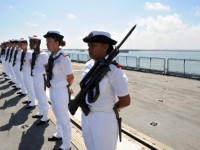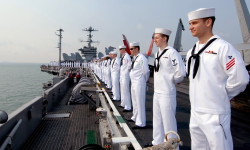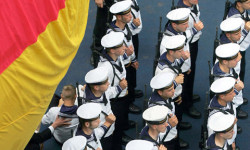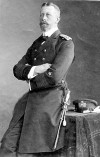The French Navy is a part of the French armed forces and next to the British Royal Navy, the second largest Western European Navy with around 45,000 soldiers and civilians.
Since February 2008, Admiral Pierre-François Forissier has been in command as Commander-in-Chief and Chief of the Naval Command.
The most important bases are Brest on the Atlantic and Toulon on the Mediterranean. The navy is organized in five areas:
- Naval Forces (Force d'Action Navale)
- Submarine Fleet (Forces Sous-marines)
- Naval Aviation (Aéronautique navale)
- Marines (Fusiliers marins) and Naval Command Special Forces (Commandos de Marine)
- Coast Guard (gendarmerie maritime)
Team's ranks of the French navy
- Matelot (sailor)
- Matelot breveté (Private first class)
- Quartier maître de 2ème classe (Upper private first class)
- Quartier maître de 1ère classe (Main private first class)
Matelot (sailor) (1), Matelot breveté (Private first class) (2), Quartier maître de 2ème classe (Upper private first class) (3), Quartier maître de 1ère classe (Main private first class) (4)
Noncommissioned officers of the French navy
- Éleve maîstrancier (Quarter master pupil)
- Second maître maistrancier (quartermaster)
- Second maître (Leading seaman)
- Maître (boatswain)
Éleve maîstrancier (Quarter master pupil) (5), Second maître maistrancier (quartermaster) (6), Second maître (Leading seaman) (7), Maître (boatswain) (8)
Higher noncommissioned officers of the French navy
- Premier maître (Chief Petty Officer)
- Maître principal (Main boat man)
- Major (Staff boat man)
Premier maître (Chief Petty Officer) (9), Maître principal (Main boat man) (10), Major (Staff boat man) (11)
Staff and subaltern officers of the French Navy
- Élève-officier (Officer school candidate)
- Aspirant der École Navale (Aspirant of Naval School)
- Enseigne de vaisseau de deuxième classe (Second lieutenant to sea)
- Enseigne de vaisseau de première classe (First lieutenant to sea)
- Lieutenant de Vaisseau (Captain second lieutenant)
- Capitaine de Corvette (Lieutenant commander)
- Capitaine de Frégate (Commander)
- Ingenieur en chef (Leading engineer)
- Capitaine de Vaisseau (Captain to sea)
Élève-officier (12), Aspirant der École Navale (Aspirant of Naval School) (13), Enseigne de vaisseau de deuxième classe (14), Enseigne de vaisseau de première classe (15), Lieutenant de Vaisseau (16), Capitaine de Corvette (17), Capitaine de Frégate (18), Ingenieur en chef (19), Capitaine de Vaisseau (20)
Admirals of the French Navy
- Contre-amiral (Flotilla admiral)
- Vice-amiral (Countering admiral)
- Vice-amiral d’escadre (Vice Admiral)
- Amiral (Admiral)
Contre-amiral (Flotilla admiral) (21), Vice-amiral (Countering admiral) (22), Vice-amiral d’escadre (Vice Admiral) (23), Amiral (Admiral) (24)
You can find the right literature here:
The Modern French Navy
An up-to-date listing of the ships and aircraft of the French Navy. Over 120 colour images.
French Destroyers: Torpilleurs D'escadre and Contre-Torpilleurs,1922-1956
Between the wars the French produced some of the largest, and certainly the fastest, destroyers in the world. Known as Contre-Torpilleurs, these striking and innovatory super-destroyers form the core of this book, but the more conventional Torpilleurs d'Escadre are also covered. This history combines the technical and service material published in French-language monographs over the past two decades with the authors' own research from primary sources.
The structure of the book follows that of the highly successful French Cruisers, with Part I devoted to the design of each of the classes built after 1922. The text is accompanied by detailed data tables and illustrated by a comprehensive set of specially-drawn plans and schemas based on official documents, as well as carefully-selected photographs from French naval sources and from private collections. Coverage runs down to the Le Hardi class, the last pre-war design..
Part II deals with the historical side, covering the eventful careers of these ships before, during and after the war. This section is illustrated by maps specially drawn for the book, and by contemporary photographs.
Like its highly successful predecessors, French Battleships and French Cruisers, this beautifully presented book blends technical and historical analysis to produce what must become the standard English-language reference work.
French Battleships, 1922-1956
The battleships of the Dunkerque and Richelieu classes were the most radical and influential designs of the interwar period, and were coveted by the British, the Germans and the Italians following the Armistice of June 1940. After an extensive refit in the USA, Richelieu went on to serve alongside the Royal Navy during 1943-45.
Using a wealth of primary-source material, some of which has only recently been made available, John Jordan and Robert Dumas have embarked on a completely new study of these important and technically interesting ships. A full account of their development is followed by a detailed analysis of their design characteristics, profusely illustrated by inboard profiles and schematic drawings. The technical chapters are interspersed with operational histories of the ships, with a particular focus on the operations in which they engaged other heavy units: Mers el-Kebir, Dakar and Casablanca. These accounts include a detailed analysis of their performance in action and the damage sustained, and are supported by specially-drawn maps and by the logs of Strasbourg and Richelieu.
Twenty-two colour profile and plan views illustrate the ships' appearance at the various stages of their careers.
French Cruisers, 1922-1956
The French produced some of the most striking and innovative interwar cruiser designs. A large amount of new information about these ships has become available over the past twenty years in France, but this book is the first to make this accessible to an English-speaking readership.
Part I explains the design philosophy behind each of the classes built after 1922, and outlines the characteristics of each type, accompanied by detailed data tables and a comprehensive set of specially-drawn plans based on official documents, as well as carefully-selected photographs. Part II deals with the historical side, covering not only the eventful careers of these ships in both war and peace. Like its highly successful predecessor, French Battleships, this beautifully presented book subtly blends technical and historical analysis to produce what must become the standard reference work.
The French Navy in World War II
Prior to this book's original publication in 1959 little had been done to dispel confusion regarding what really happened to the French Navy during World War II. Few people realized the tragic situation of a country forced to capitulate to a traditional enemy. After this humiliating experience, the Navy, in its attempts to preserve France's foreign possessions, and to supply the mother country, found itself torn between the conflicting interests of involved internal and international politics. Forced to scuttle part of the fleet at Toulon, the remainder found themselves viewed with wary suspicion by both the Germans and the Allies.
That the French Navy was able to survive at all is a minor miracle. That it so well preserved its unanimity as to return to the fight and participate in the final victory is in itself a tribute to the moral, discipline, and traditions that date back to the crusades. The French Navy in World War II is now available in paperback.
This post is also available in:
 Deutsch (German)
Deutsch (German)  Français (French)
Français (French)  Italiano (Italian)
Italiano (Italian)  简体中文 (Chinese (Simplified))
简体中文 (Chinese (Simplified))  Русский (Russian)
Русский (Russian)  Español (Spanish)
Español (Spanish)  العربية (Arabic)
العربية (Arabic)























